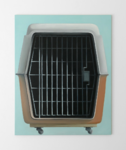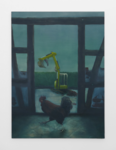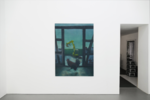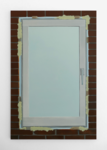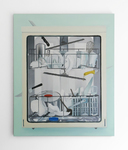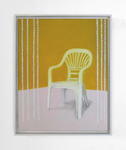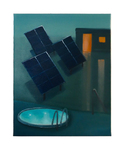Gothenburg, August 7, 2019
Dear Simon,
In Virginia Woolf’s To the Lighthouse, an artist returns to the house of a dead friend. She goes there to complete a portrait of her friend. Many years have passed since she began to work with the painting. Now that she continues, it is not only the house, the familiar things inside, and the light house that she sees from the window, that reawakens the past, but also the paint in itself: ”And as she dipped into the blue paint, she dipped too into the past there.”
I love this book and I came to think about it after our conversation last week. You told me that you always paint from memory. I wonder if it is the same for you, as for the artist Lily in the novel: if the colours of the paint and the very act of painting helps you to remember, so that the recollection is complete first when you have finished the painting? If so, painting deals with memory in a wholly different way than for example photography.
It is often said that memories are individual, and history collective. I don’t believe so. I’m pretty sure that I’ve (accidentally) stolen other person’s memories. And now I’m afraid I’m about to steal yours. The thing is that many of the motifs in your works are so familiar to me. Sometimes, it’s almost as if they were made by pieces from my own messy archive of wanted and unwanted recollections. To look at your works is a bit like remembering to me.
Your paintings obviously have nothing to do with my past. My guess is that many of them originate from Ottersberg, where you grew up – a place that I’ve never visited. I grew up in Kolsva, a small mill village in Sweden, almost 1000 kilometres away from Ottersberg. But the fact is that everything in your works (except for the solar panels) is also very characteristic for Kolsva. I’m not only thinking about the material stuff, such as the white plastic chairs, the hot tubs, and the crocs sandals, but also about the loneliness, the absurdity, the humour and the ”sachlichkeit”.
Since your works to me are about my home village, I’m very happy that they all have such a friendly and respectful aura. Nowadays, the rural area is seldom portrayed in a very flattering way. Small industrial towns and mill villages are always described as decaying places and the people who live there are suspected to be ignorant and vulnerable to right-wing propaganda. These places may have a glorious past, but no future at all. The future belongs to the big cities, and so do all the successful people. I think this picture is deeply unjust and erroneous. For one reason, because it is based on an idea of the big city that is no longer true, at least not for most European cities.
The sociologist Richard Sennett phrased this idea in a beautiful way: ”A city is a milieu where strangers are likely to meet”. This is of course what we all want the city to be, but it isn’t any more. Because of gentrification, people in the cities are not likely to meet strangers there anymore. Instead, they only meet people like themselves. The cities may look like cities, be as big as cities, sound like cities, and sometimes also smell like cities, but they are not cities anymore! If you want to meet a stranger, you must go to a place like Kolsva. There you can for example meet a very nice man from Syria, who was a successful dancer before he fled with his wife and they ended up in Kolsva. He has plenty of stories to tell. (You will probably meet him at the gym close to the gas station, which I’ve done several times.)
I think that the grand idea of the city as a melting pot of cultures, dreams, and ideas nowadays is to be found on the countryside.
The village has become the true city.
My best,
Jens
P.S. I’ve never met many strangers in for example Stockholm, although I lived there for many years, but in Berlin I have, and some of them have also become my friends. I think Berlin might still be a city, and I sincerely hope that it will remain a city for a while.
Letter from Jens Soneryd to Simon Modersohn, ”Dauerauftrag”. August 10–24, 2019. Åplus, Berlin.
Å+ Simon Modersohn Dauerauftrag.pdf
PDF-Dokument [11.5 MB]


